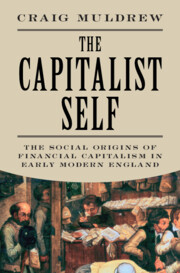Book contents
- The Capitalist Self
- The Capitalist Self
- Copyright page
- Dedication
- Contents
- Figures
- Tables
- Acknowledgements
- Introduction: Capitalism and Dependence
- 1 Early Modern Capitalism: A Concept Too Big to Fail?
- 2 Value in Motion: The Inheritance of Merchant Capital and Debates over Credit
- 3 The Financial Revolution in English Localities
- 4 Little Land Banks: The Mortgaging Revolution and Savings on Bond
- 5 An Ethical Fulcrum: From Participation in the Body of Christ to the Happy Self
- 6 Practical Ethics, the Self, and the Economy in an Era of Religious Dissent
- 7 The Transformation of Legal Culture
- 8 The Dark Side of Thrift: Capital and Class Formation – Institutional Stability and Ethical Inequality
- 9 The Success of the First ‘Modern’ Banks: Scotland and the Thirteen Colonies, and Failure in France
- 10 The Emergence of Local Bankers in England: Savings and Adam Smith’s ‘Capitalism’
- Conclusion
- Select Bibliography
- Index
2 - Value in Motion: The Inheritance of Merchant Capital and Debates over Credit
Published online by Cambridge University Press: 12 October 2025
- The Capitalist Self
- The Capitalist Self
- Copyright page
- Dedication
- Contents
- Figures
- Tables
- Acknowledgements
- Introduction: Capitalism and Dependence
- 1 Early Modern Capitalism: A Concept Too Big to Fail?
- 2 Value in Motion: The Inheritance of Merchant Capital and Debates over Credit
- 3 The Financial Revolution in English Localities
- 4 Little Land Banks: The Mortgaging Revolution and Savings on Bond
- 5 An Ethical Fulcrum: From Participation in the Body of Christ to the Happy Self
- 6 Practical Ethics, the Self, and the Economy in an Era of Religious Dissent
- 7 The Transformation of Legal Culture
- 8 The Dark Side of Thrift: Capital and Class Formation – Institutional Stability and Ethical Inequality
- 9 The Success of the First ‘Modern’ Banks: Scotland and the Thirteen Colonies, and Failure in France
- 10 The Emergence of Local Bankers in England: Savings and Adam Smith’s ‘Capitalism’
- Conclusion
- Select Bibliography
- Index
Summary
This chapter outlines the history of previous institutions that created forms of capital in Europe, including land, dowries, banks, bills of exchange, and government debt. It examines the reasons why the system of informal oral credit, as it had developed over the previous 100-odd years, began to be criticised during the Commonwealth period. Many authors started to claim that it was both inefficient and an obstacle to economic growth. Many pamphlets were published containing proposals of different sorts of banks, which would issue paper currency to speed up circulation. Some of these were based on previous European examples. The nature of these proposals is examined, together with a summary of how they related to the creation of the Bank of England. Its establishment is normally seen as the successful outcome of this debate, but in fact it was not primarily created as an institution to expand the supply of credit, but to help fund the government debt. The increasing cost of the War of Spanish Succession did, however, result in the issue of things like Exchequer or Treasury bills, as well as South Sea and Bank stock to fund the war. The last part of the chapter focuses on the significant effect these multiple forms of paper currency had on liquidity within London.
Keywords
Information
- Type
- Chapter
- Information
- The Capitalist SelfThe Social Origins of Financial Capitalism in Early Modern England, pp. 57 - 100Publisher: Cambridge University PressPrint publication year: 2025
Accessibility standard: Inaccessible, or known limited accessibility
Content Navigation
Allows you to navigate directly to chapters, sections, or non‐text items through a linked table of contents, reducing the need for extensive scrolling.
Provides an interactive index, letting you go straight to where a term or subject appears in the text without manual searching.
Reading Order & Textual Equivalents
You will encounter all content (including footnotes, captions, etc.) in a clear, sequential flow, making it easier to follow with assistive tools like screen readers.
You get concise descriptions (for images, charts, or media clips), ensuring you do not miss crucial information when visual or audio elements are not accessible.
You get more than just short alt text: you have comprehensive text equivalents, transcripts, captions, or audio descriptions for substantial non‐text content, which is especially helpful for complex visuals or multimedia.
Visual Accessibility
You will still understand key ideas or prompts without relying solely on colour, which is especially helpful if you have colour vision deficiencies.
You benefit from high‐contrast text, which improves legibility if you have low vision or if you are reading in less‐than‐ideal lighting conditions.
